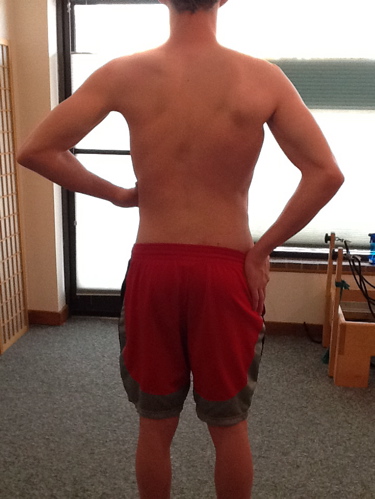Summertime – green and gorgeous, heat waves that influence us to wear the minimum clothing needed, bathing suits, sports and camps. This is often the first opportunity parents have to notice scoliosis forming in their growing adolescent’s spine. There may be differences in the height of the child’s shoulders. One hip may appear “shifted” out to the side from a front or back view. If you are the first to notice this, it is worth following up on. Maybe this child spends long periods in extreme postures like slouching or some other unusual “habit” of holding themselves that seems hard to break.
These are signs that some guided activities to re-balance their bodies could make a significant difference in their development. Maybe your child is growing so rapidly you hardly recognize them from one day to the next; they hardly recognize themselves one day to the next. This is an important time to keep an eye on their spine! We are 3 dimensional beings. Looking at a person from the side gives a perspective of front to back balance (sagittal plane). While it is normal to have a small kyphosis or outward curve of the upper back, and a small lordosis or inward curve of the lower back, when these curves become habitually exaggerated, the loss of front to back balance can result in movement dysfunction or compensations that begin to affect other planes of movement. Looking at a person from the back or front may reveal side to side asymmetries (frontal plane or coronal plane). While everybody has minor asymmetries, the development of noticeable differences side to side may be significant. Scoliosis is a side to side or frontal plane change in which the spine is no longer vertical, but begins to curve sideways and later, also to rotate (transverse plane). This change often occurs in a very flexible, often active, young person who already has an exaggerated lordosis or sway back. It usually occurs during periods of rapid growth.
Early detection and treatment can be remarkably effective. Although current U.S. conventional medical opinion favors a “wait and see ” approach, at our clinic, we have experienced 2 powerful perspectives:
1). Waiting to see if curvatures will progress often results in the necessity for surgery when the curve reaches the 40 – 60 degree Cobb angle range. Patients who wait until their curve is in the 30 – 50 degree Cobb angle range, and seek rehabilitation at that time to try to avoid surgery, require bracing and intensive rehab programs. This approach can be very effective, but requires an strong commitment by the young person, and their parents, to the process.
2). Parents who have noticed in their child some of the features mentioned above, or who have received a diagnosis of mild curvature ( in the 10 – 20 degree Cobb angle range), and who have chosen to seek rehab treatment to immediately address these early signs – and not wait – have been able to reverse or avoid the development of scoliosis. Summer is green and gorgeous and a great time to keep an eye on your children’s posture and movement.







